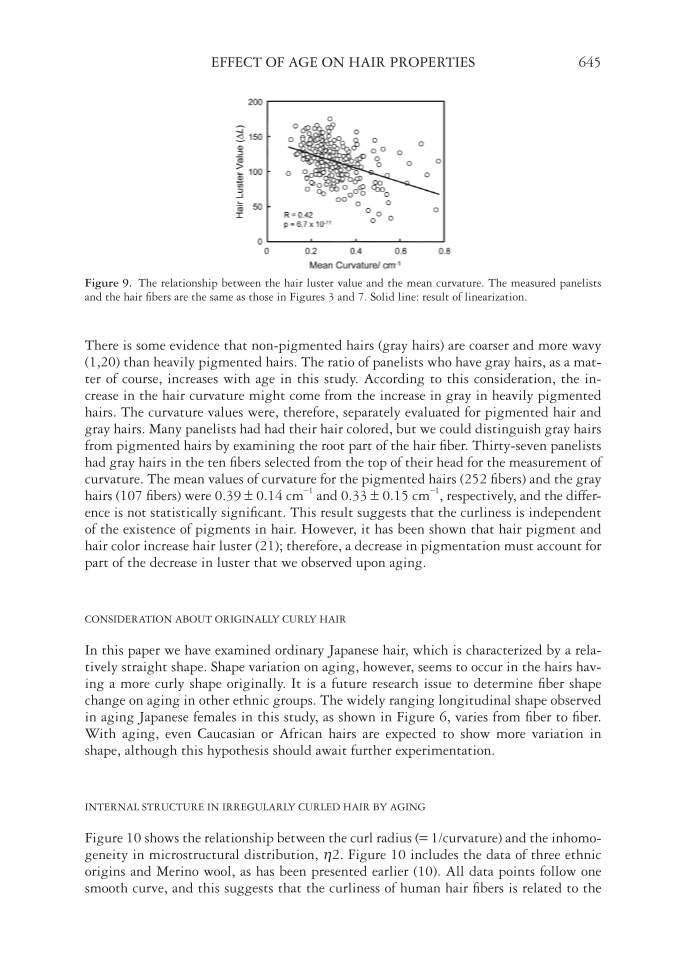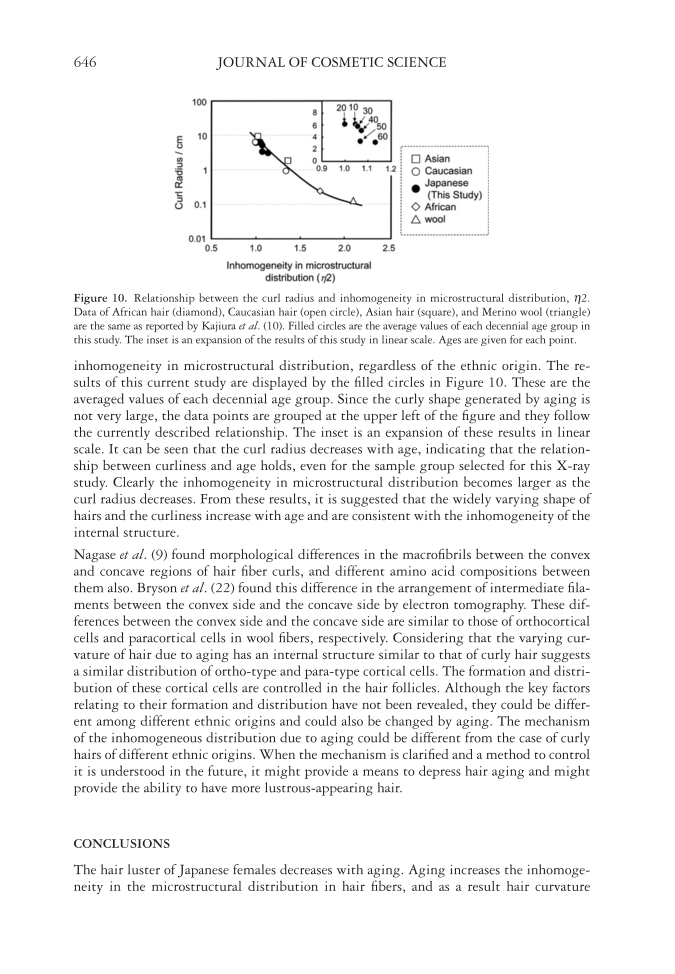EFFECT OF AGE ON HAIR PROPERTIES 645 There is some evidence that non-pigmented hairs (gray hairs) are coarser and more wavy (1,20) than heavily pigmented hairs. The ratio of panelists who have gray hairs, as a mat- ter of course, increases with age in this study. According to this consideration, the in- crease in the hair curvature might come from the increase in gray in heavily pigmented hairs. The curvature values were, therefore, separately evaluated for pigmented hair and gray hairs. Many panelists had had their hair colored, but we could distinguish gray hairs from pigmented hairs by examining the root part of the hair fi ber. Thirty-seven panelists had gray hairs in the ten fi bers selected from the top of their head for the measurement of curvature. The mean values of curvature for the pigmented hairs (252 fi bers) and the gray hairs (107 fi bers) were 0.39 ± 0.14 cm−1 and 0.33 ± 0.15 cm−1, respectively, and the differ- ence is not statistically signifi cant. This result suggests that the curliness is independent of the existence of pigments in hair. However, it has been shown that hair pigment and hair color increase hair luster (21) therefore, a decrease in pigmentation must account for part of the decrease in luster that we observed upon aging. CONSIDERATION ABOUT ORIGINALLY CURLY HAIR In this paper we have examined ordinary Japanese hair, which is characterized by a rela- tively straight shape. Shape variation on aging, however, seems to occur in the hairs hav- ing a more curly shape originally. It is a future research issue to determine fi ber shape change on aging in other ethnic groups. The widely ranging longitudinal shape observed in aging Japanese females in this study, as shown in Figure 6, varies from fi ber to fi ber. With aging, even Caucasian or African hairs are expected to show more variation in shape, although this hypothesis should await further experimentation. INTERNAL STRUCTURE IN IRREGULARLY CURLED HAIR BY AGING Figure 10 shows the relationship between the curl radius (= 1/curvature) and the inhomo- geneity in microstructural distribution, η2. Figure 10 includes the data of three ethnic origins and Merino wool, as has been presented earlier (10). All data points follow one smooth curve, and this suggests that the curliness of human hair fi bers is related to the Figure 9. The relationship between the hair luster value and the mean curvature. The measured panelists and the hair fi bers are the same as those in Figures 3 and 7. Solid line: result of linearization.
JOURNAL OF COSMETIC SCIENCE 646 inhomogeneity in microstructural distribution, regardless of the ethnic origin. The re- sults of this current study are displayed by the fi lled circles in Figure 10. These are the averaged values of each decennial age group. Since the curly shape generated by aging is not very large, the data points are grouped at the upper left of the fi gure and they follow the currently described relationship. The inset is an expansion of these results in linear scale. It can be seen that the curl radius decreases with age, indicating that the relation- ship between curliness and age holds, even for the sample group selected for this X-ray study. Clearly the inhomogeneity in microstructural distribution becomes larger as the curl radius decreases. From these results, it is suggested that the widely varying shape of hairs and the curliness increase with age and are consistent with the inhomogeneity of the internal structure. Nagase et al. (9) found morphological differences in the macrofi brils between the convex and concave regions of hair fi ber curls, and different amino acid compositions between them also. Bryson et al. (22) found this difference in the arrangement of intermediate fi la- ments between the convex side and the concave side by electron tomography. These dif- ferences between the convex side and the concave side are similar to those of orthocortical cells and paracortical cells in wool fi bers, respectively. Considering that the varying cur- vature of hair due to aging has an internal structure similar to that of curly hair suggests a similar distribution of ortho-type and para-type cortical cells. The formation and distri- bution of these cortical cells are controlled in the hair follicles. Although the key factors relating to their formation and distribution have not been revealed, they could be differ- ent among different ethnic origins and could also be changed by aging. The mechanism of the inhomogeneous distribution due to aging could be different from the case of curly hairs of different ethnic origins. When the mechanism is clarifi ed and a method to control it is understood in the future, it might provide a means to depress hair aging and might provide the ability to have more lustrous-appearing hair. CONCLUSIONS The hair luster of Japanese females decreases with aging. Aging increases the inhomoge- neity in the microstructural distribution in hair fi bers, and as a result hair curvature Figure 10. Relationship between the curl radius and inhomogeneity in microstructural distribution, η2. Data of African hair (diamond), Caucasian hair (open circle), Asian hair (square), and Merino wool (triangle) are the same as reported by Kajiura et al. (10). Filled circles are the average values of each decennial age group in this study. The inset is an expansion of the results of this study in linear scale. Ages are given for each point.
Purchased for the exclusive use of nofirst nolast (unknown) From: SCC Media Library & Resource Center (library.scconline.org)

































































































